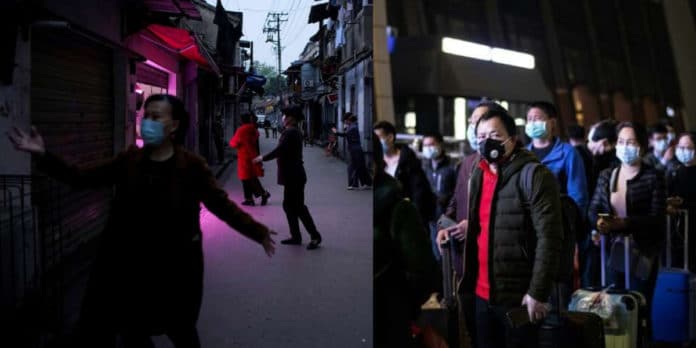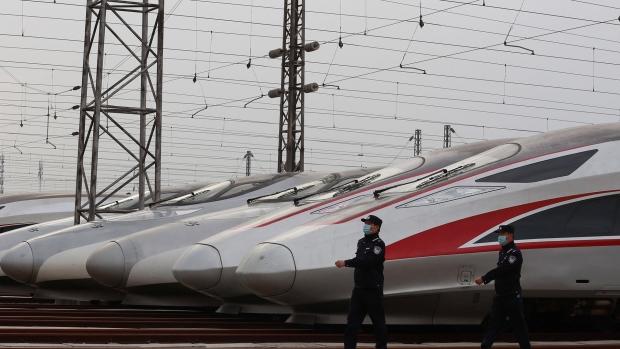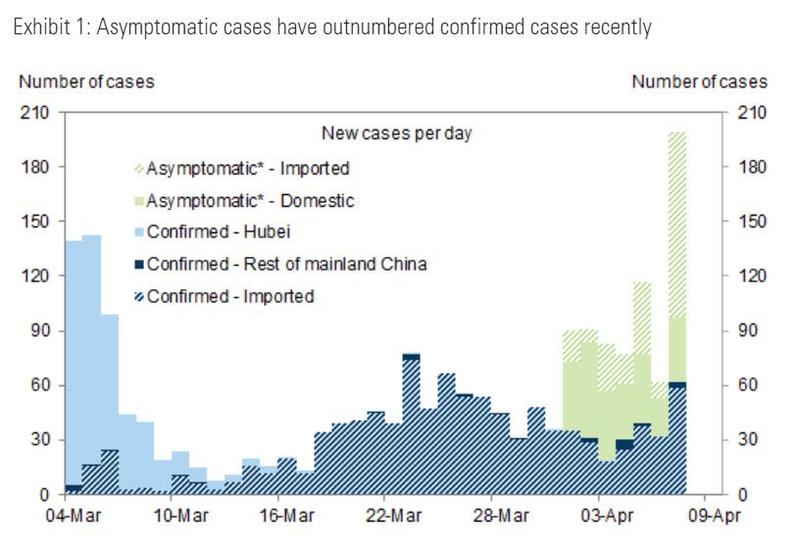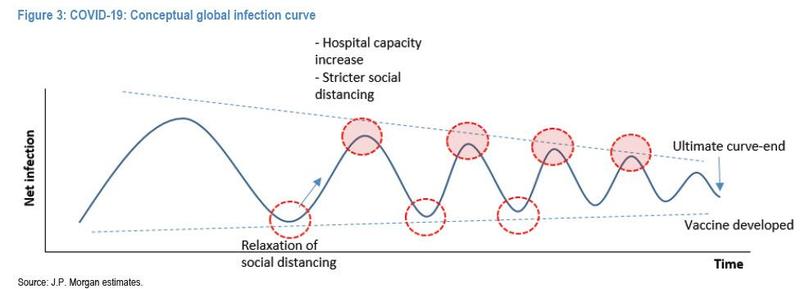
Last week we reported that even as the world’s attention had shifted to the new global coronavirus outbreak epicenters of New York, Italy, Spain and other western nations, China – which rushed to restart its economy at any cost – had put a major county on lockdown after a new cluster of coronavirus infection had emerged. To wit, last Wednesday we learned that in post on its social media account, Jia county – which has a population of about 600,000 – said that no one can travel out of Jia county without proper authorization after one person tested positive.
This new cluster emerged just days after China once again revised its virus reporting methodology to also include asymptomatic carriers of the disease, which naturally begged the question why China wasn’t reported his subset of infections previously.
We got the answer yesterday when Mainland China reported 39 new coronavirus cases as of Sunday, up from 30 a day earlier, and the number of asymptomatic cases also surged, as Beijing continued to struggle to extinguish the outbreak despite drastic containment efforts. China’s National Health Commission said in a statement on Monday that 78 new asymptomatic cases had been identified as of the end of the day on Sunday, compared with 47 the day before. Of the new cases showing symptoms, 38 were people who had entered China from abroad, compared with 25 a day earlier, although how China keeps track of this on an instantaneous basis is unclear. Also it’s odd to blame “imports” as China also closed off its borders to foreigners, though according to Beijing most imported cases involve Chinese nationals returning from overseas.
This means that whether asymptomatic or not, imported or domestic, Hubei-based or not, on April 5, China reported the most new Coronavirus cases in a month as slowly the disease appears to be reestablishing itself in the world’s most populous nation.
This is a problem because it suggests that despite the now chronic data obfuscation, China may be about to unleash to a second wave of coronavirus infections – both domestically and internationally – something JPMorgan predicted is virtually inevitable.
It’s an even bigger problem because at midnight on Wednesday, China ended its lockdown of Wuhan, the city where the coronavirus first emerged and remains the symbol of a pandemic that has killed tens of thousands of people, shaken the global economy and thrown daily life into upheaval across the planet.
Alas, as the NYT reports, the city that has reopened after more than 10 weeks is a profoundly damaged one, a place whose recovery will be watched worldwide for lessons on how populations move past pain and calamity of such staggering magnitude. What’s worse, is that judging by the latest reports, a new cluster of cases may be emerging and since Wuhan was ground zero, the risk is that by reopening Wuhan, China may be about to restart a whole new global wave of infections.

But first, a little background.
Chinese authorities sealed off Wuhan, an industrial hub of 11 million people, in late January, in a frantic attempt to limit the outbreak’s spread. At the time, many outsiders saw it as an extreme step, one that could be tried only in an authoritarian system like China’s. But as the epidemic has worsened, governments around the world have enacted a variety of stringent restrictions on their citizens’ movements.
Wuhan was by far the worst-hit part of the country, accounting for 50,008 confirmed coronavirus cases—61% of China’s total—and 2,571 deaths, or 77% of the national toll, according to official figures as of Monday.
Meanwhile, some 1.4 million infections and 80,000 deaths have been reported worldwide — figures that are rising fast, and that officials say vastly understate the true extent of the pandemic, a pandemic which despite mainstream attempts to shift the topic, most likely emerged as a result of deadly leak (an involuntary one, one assumes) from the Wuhan Institute Of Virology. The contagion has slowed in hard-hit countries like Italy and Spain, but it continues to spread quickly elsewhere around the globe, including in the United States, which is approaching 400,000 known infections.
News reports are filled with scenes of overflowing hospitals in New York City, uncollected bodies on streets in Ecuador, updates on the condition of Prime Minister Boris Johnson of Britain, who is hospitalized in intensive care, and expert warnings that the epidemic could be exploding, undetected, in the poorest parts of the world. Most of Europe, India, much of the United States and many other places are under orders for businesses to close and most people to stay at home, abruptly crippling economies and throwing millions of people out of work.
Yet as the world grapples with how to minimize transmission and isolate potential carriers by preaching a culture of “social distancing”, China is doing the opposite, and taking a massive gamble by allowing potential carriers to resume their normal social interactions with countless people.
To be sure, that’s not how Beijing sees it: Wednesday’s reopening of Wuhan came after only three new coronavirus cases were reported in the city in the previous three weeks, and a day after China reported no new deaths for the first time since January. The report that China is fine sparked ridicule from such Sinophobes as Heyman Capital’s Kyle Bass who did not exactly believe China’s “data” to put it mildly:
https://twitter.com/Jkylebass/status/1247600908025901068?
Meanwhile, speculation is rife that the real infection numbers for Wuhan could be more than double that, according to two recent studies that estimated that the cumulative total for the city was already higher than 125,000 in February according to the WSJ. One study, by University of Hong Kong researchers, noted that China changed its criteria for diagnosis six times, including on Feb. 4, when it widened the testing pool considerably, leading to a surge in confirmed cases. If testing capabilities were available throughout the outbreak, and the Feb. 4 criteria had been applied throughout China’s crisis, 232,000 cases could have been detected in China by Feb. 20, with 127,000 cases in Wuhan alone, the researchers estimated. Additionally, as the WSJ also notes, experts and residents believe the official death toll excludes those who died at home or couldn’t be tested early on.
Epidemiologists, US intelligence sources and Wuhan residents suspect that Chinese authorities substantially undercounted infections and deaths over the past several months, especially in Wuhan, in part to boost President Xi Jinping’s image.
Some of the clearest indications that nothing is fixed comes from Wuhan itself: while some life, and traffic, have returned to Wuhan’s streets in recent days, most shops and restaurants are still closed. Local officials in full protective gear still guard entrances to residential neighborhoods, some of which are barricaded with metal fencing and awning.
Authorities who had cut back on testing after conditions improved have ramped them back up, testing 12,000 people a day on average the past two weeks—60% more than New York City. Nationwide testing numbers haven’t been made public, and even if they were, the results would show only whatever Beijing wants.
Until April 1, China didn’t publish figures for asymptomatic cases, which it defines as people who don’t yet show symptoms but have tested positive and could be infectious. Since then, Wuhan authorities have reported 194 new asymptomatic cases. They also said a total of 658 asymptomatic cases were under medical observation as of Monday. Health Times, a publication affiliated with the Communist Party’s official People’s Daily newspaper, quoted a senior doctor in Wuhan saying there could be 10,000 to 20,000 asymptomatic cases there, according to a survey done in the previous three days. The online articles was promptly deleted after it was published.
Most skeptical that the Wuhan crisis has been solved are the city’s own residents, who say they are skeptical in part because local authorities tried to cover up the scale of the problem early on. Police reprimanded several people who tried to issue warnings via social media and officials warned doctors not to speak publicly about the disease. Restrictions on people retrieving deceased relatives’ ashes from funeral homes ahead of last Saturday’s Tomb Sweeping festival, a day when many Chinese visit ancestors’ graves, also aroused suspicions. Officials banned people from observing Tomb Sweeping rituals until April 30, saying it was to avoid cemetery overcrowding.
 Wuhan’s cemeteries and crematoriums have been heavily manned with police and other officials, with makeshift tents and desks erected outside to process grieving relatives. At the Biandanshan cemetery, Wuhan’s largest, an epidemic control official said there had been dozens of funerals there in recent days, a little more than normal, due to a backlog from the lockdown, when the cemetery was closed.
Wuhan’s cemeteries and crematoriums have been heavily manned with police and other officials, with makeshift tents and desks erected outside to process grieving relatives. At the Biandanshan cemetery, Wuhan’s largest, an epidemic control official said there had been dozens of funerals there in recent days, a little more than normal, due to a backlog from the lockdown, when the cemetery was closed.
Such doubts, combined with the reports of new asymptomatic cases, are triggering fears of a potential second wave of infections that could undermine Beijing’s claim to have tamed the virus.
Yet despite the all too real possibility that Wuhan is a ticking timebomb, ready to unleash a second wave of coronavirus infections on the world – and this time with mutations, making any potential immunity from the first wave null and void – China is scrambling to show to the world just how successful it has been in fixing its own crisis, and Chinese authorities lifted the mass quarantine of Hubei province except for Wuhan, its capital, on March 25.
* * *
As for Wuhan, after 76 days in quarantine the city’s lockdown – as well as controls on outbound travel – have now been lifted, just after midnight in China with authorities encouraging resumption of business operations for this critical industrial hub.
https://twitter.com/Jkylebass/status/1247600908025901068?

Which means that despite the mounting skepticism about what the full extent of the disease was in ground zero, and whether it has even been contained, starting Wednesday morning people can now leave after presenting to the authorities a government-sanctioned phone app that indicates — based on their home addresses, recent travels and medical histories — whether they are contagion risks. Of course, since this is a city of 11 million, there is no possible way that the local authorities will be enable to enforce this “filter.”
The consequences – for China and the world – could be dire. Footage from state-run news outlets early Wednesday showed a rush of cars traveling through toll stations on the outskirts of Wuhan immediately after the restrictions were lifted.
Cars leaving Wuhan: officials tell us that in seven hours since the lockdown lifted, 970 passenger vehicles have left the city pic.twitter.com/kn3vV3vSaE
— Elizabeth Law 思敏 (@lizzlaw_) April 8, 2020
China’s Global Times took pride in showing that on Wednesday morning an airplane departed from Wuhan Tianhe International Airport to Sanya in South China’s Hainan Province on Wed. It was the first flight leaving the airport after Wuhan’s 76-day lockdown.
A China Eastern airplane departs from #Wuhan Tianhe International Airport at 7:24 to Sanya in South China’s Hainan Province on Wed. It is the first flight leaving the airport after Wuhan's 76-day lockdown. pic.twitter.com/jyjeHvb9ke
— Global Times (@globaltimesnews) April 8, 2020
First train, plane leave #Wuhan as city ends lockdown https://t.co/NCZXO1GuIw pic.twitter.com/E72NwfEhrd
— CGTN (@CGTNOfficial) April 8, 2020
But most terrifying is that, according to a state-run broadcaster, China’s national rail operator estimated that more than 55,000 people would leave Wuhan by train on Wednesday alone.
At Wuhan’s Hankou train station. One of the first trains is departing the city is to nearby Jinzhou now. Passengers on the train said they’d been looking forward to leaving, to reuniting with family outside, for weeks. pic.twitter.com/OBCvnMqktv
— Emily Feng 冯哲芸 (@EmilyZFeng) April 7, 2020
Wuhan restarts tomorrow! High-speed trains in arrays are ready for departure, on Wed, from three train stations of #Wuhan after a 76-day lockdown. Wuhan will lift its outbound travel restrictions starting from Wed. #COVID19 pic.twitter.com/s70NOoP6xd
— Global Times (@globaltimesnews) April 7, 2020
According to cp24.com, “tickets for trains out of Wuhan to cities across China already were advertised on electronic billboards, with the first train leaving for Beijing at 6:25 a.m. A line designated for passengers headed to the capital already was roped off.”
In preparation for the end of the lockdown, Party Secretary Wang Zhonglin, the city’s highest-ranking official, inspected the city’s airport and train stations Monday to ensure they were ready. The city must “enforce prevention while opening up, maintain safety and orderliness and the assurance of stability,” Wang said.
https://twitter.com/Globalpoliticss/status/1247699706203058176
In other words, the horses are fleeing the barn… and this time thousands of them could be carriers of the deadly coronavirus. What is scarier is that it is as if China wants to spread a new wave of infections around the globe.







